An Integrated Fuzzy Analytic Hierarchy Process (AHP) Model for Studying Significant Factors Associated with Frequent Lane Changing
Abstract
1. Introduction
2. Methodology
2.1. Questionnaire Survey
2.2. Factors Affecting Lane Changing
2.3. Analytic Hierarchy Process (AHP)
- Step#01: Designing the hierarchical model of assessment elements;
- Step#02: Create the survey using a fuzzy scale (1–9) for pairwise comparisons in the hierarchical structure;
- Step#03: Analyzing the consistency of pairwise comparisons;
- Step#04: Estimating the aggregated weight scores;
- Step#05: Developing the weight vectors and measuring the final weight scores by observing branch networks.
- Step#06: Conducting Sensitivity investigation
2.4. Triangular Fuzzy Sets
2.5. The Proposed Fuzzy AHP
- Step#01: Establishing the hierarchy structure of the complex problem;
- Step#02: Designing the pairwise comparison matrices by considering all factors in a hierarchy structure;
- Step#03: Evaluating pairwise comparison matrices by utilizing the fuzzy number scale (Table 6);
- Step#04: Aggregating the preferences of all evaluators by using geometric mean;
- Step#05: Calculate the final overall weights for all factors (Table 7);
- Step#06: Weights’ defuzzification;
- Step#07: Calculating th absolute weight scores by considering branch relations in the case of multilevel;
- Step#08: Checking consistency;
- Step#09: Sensitivity analysis.
3. Results
3.1. Sensitivity Analysis
3.2. Discussion
4. Conclusions
Author Contributions
Funding
Institutional Review Board Statement
Informed Consent Statement
Data Availability Statement
Acknowledgments
Conflicts of Interest
Appendix A. Sample Questionnaire Adopted for the Study
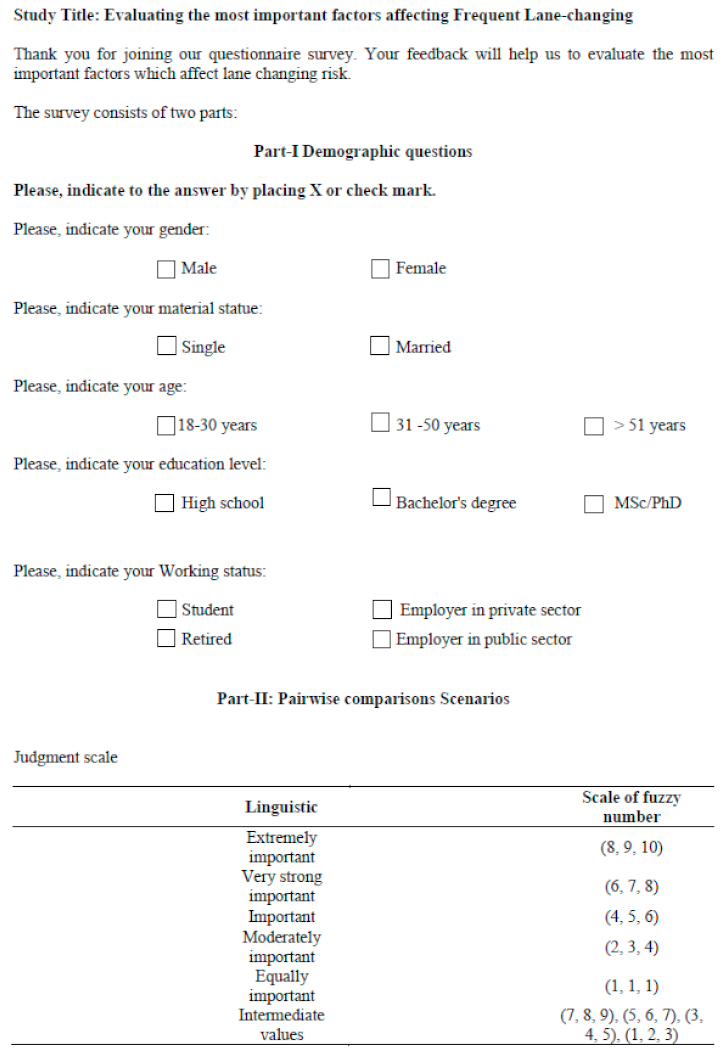
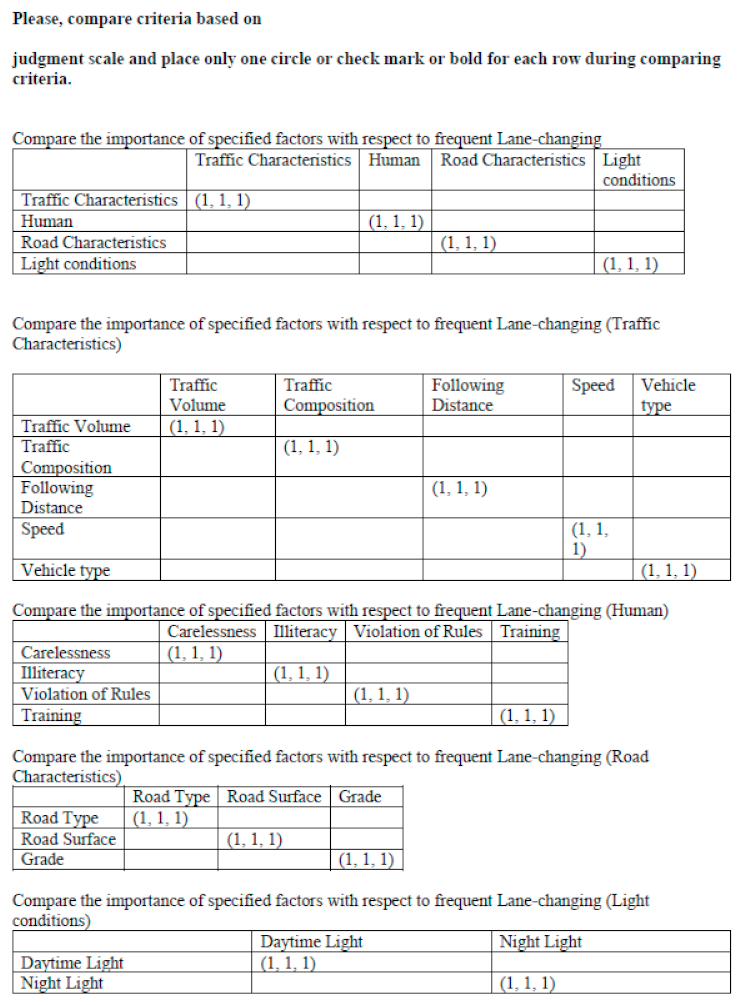
References
- Declaration, S. Third Global Ministerial Conference on Road Safety: Achieving Global Goals 2030. 2020. Available online: https://www.itf-oecd.org/3rd-global-ministerial-conference-road-safety-achieving-global-goals-2030 (accessed on 11 October 2021).
- Carson, J.; Adminaite-Fodor, D.; Jost, G. Ranking EU Progress on Road Safety: 14th Road Safety Performance Index Report. 2020. Available online: https://etsc.eu/wp-content/uploads/14-PIN-annual-report-FINAL.pdf (accessed on 10 December 2021).
- Janstrup, K.H. Road Safety Annual Report 2017. 2017. Available online: https://read.oecd-ilibrary.org/transport/road-safety-annual-report-2017_irtad-2017-en (accessed on 13 November 2021).
- Jamal, A.; Zahid, M.; Rahman, M.T.; Al-Ahmadi, H.M.; Almoshaogeh, M.; Farooq, D.; Ahmad, M. Injury Severity Prediction of Traffic Crashes with Ensemble Machine Learning Techniques: A Comparative Study. Int. J. Inj. Control Saf. Promot. 2021, 28, 408–427. [Google Scholar] [CrossRef]
- OECD/ITF. Road Safety Annual Report. 2016. Available online: https://www.itf-oecd.org/road-safety-annual-report-2016 (accessed on 5 January 2022).
- Wang, J.; Ding, J.-X.; Shi, Q.; Kühne, R.D. Lane-Changing Behavior and Its Effect on Energy Dissipation Using Full Velocity Difference Model. Int. J. Mod. Phys. C 2016, 27, 1650013. [Google Scholar] [CrossRef]
- Bernard, K. Group Accidents Nationwide Associated with Lane-Changing. 2017. Available online: https://www.4injured.com/blog/accidents-lane-changing-risks/ (accessed on 14 January 2022).
- Bernard, K. Accidents Nationwide Associated With Lane-Changing: Unsafe Car Lane Changing Accident Statistics. 2019. Available online: https://www.4injured.com/blog/accidents-lane-changing-risks/ (accessed on 18 January 2022).
- Shawky, M. Factors Affecting Lane Change Crashes. IATSS Res. 2020, 44, 155–161. [Google Scholar] [CrossRef]
- Kesting, A.; Treiber, M.; Helbing, D. General Lane-Changing Model MOBIL for Car-Following Models. Transp. Res. Rec. 2007, 1999, 86–94. [Google Scholar] [CrossRef]
- Wang, M.; Hoogendoorn, S.P.; Daamen, W.; van Arem, B.; Happee, R. Game Theoretic Approach for Predictive Lane-Changing and Car-Following Control. Transp. Res. Part C Emerg. Technol. 2015, 58, 73–92. [Google Scholar] [CrossRef]
- Wang, X.; Zhang, J.; Liu, Y.; Yunyun, W.; Wang, F.; Wang, J. The Drivers’ Lane Selection Model Based on Mixed Fuzzy Many-Person Multi-Objective Non-Cooperative Game. J. Intell. Fuzzy Syst. 2017, 32, 4235–4246. [Google Scholar] [CrossRef]
- Yu, H.; Tseng, H.E.; Langari, R. A Human-like Game Theory-Based Controller for Automatic Lane Changing. Transp. Res. Part C Emerg. Technol. 2018, 88, 140–158. [Google Scholar] [CrossRef]
- Li, K.; Wang, X.; Xu, Y.; Wang, J. Lane Changing Intention Recognition Based on Speech Recognition Models. Transp. Res. Part C Emerg. Technol. 2016, 69, 497–514. [Google Scholar] [CrossRef]
- Farooq, D.; Juhasz, J. Simulation-Based Analysis of the Effect of Significant Traffic Parameters on Lane Changing for Driving Logic “Cautious” on a Freeway. Sustainability 2019, 11, 5976. [Google Scholar] [CrossRef]
- Danish, F.; Juhasz, J. An Investigation of Speed Variance Effect on Lane-Changing for Driving Logic “Cautious” on Highways. Adv. Transp. Stud. Int. J. 2020, 51, 109–120. [Google Scholar]
- Li, A.; Sun, L.; Zhan, W.; Tomizuka, M. Multiple Criteria Decision-Making for Lane-Change Model. arXiv 2019, arXiv:1910.10142. [Google Scholar]
- Kahraman, C.; Kaya, İ.; Cebi, S. A Comparative Analysis for Multiattribute Selection among Renewable Energy Alternatives Using Fuzzy Axiomatic Design and Fuzzy Analytic Hierarchy Process. Energy 2009, 34, 1603–1616. [Google Scholar] [CrossRef]
- Wang, Y.; Yang, W.; Li, M.; Liu, X. Risk Assessment of Floor Water Inrush in Coal Mines Based on Secondary Fuzzy Comprehensive Evaluation. Int. J. Rock Mech. Min. Sci. 2012, 52, 50–55. [Google Scholar] [CrossRef]
- Farooq, D.; Moslem, S.; Duleba, S. Evaluation of Driver Behavior Criteria for Evolution of Sustainable Traffic Safety. Sustainability 2019, 11, 3142. [Google Scholar] [CrossRef]
- Tüysüz, F.; Kahraman, C. Project Risk Evaluation Using a Fuzzy Analytic Hierarchy Process: An Application to Information Technology Projects. Int. J. Intell. Syst. 2006, 21, 559–584. [Google Scholar] [CrossRef]
- Moslem, S.; Duleba, S. Sustainable Urban Transport Development by Applying a Fuzzy-AHP Model: A Case Study from Mersin, Turkey. Urban Sci. 2019, 3, 55. [Google Scholar] [CrossRef]
- Srisawat, P.; Kronprasert, N.; Arunotayanun, K. Development of Decision Support System for Evaluating Spatial Efficiency of Regional Transport Logistics. Transp. Res. Procedia 2017, 25, 4832–4851. [Google Scholar] [CrossRef]
- Nanda, S.; Singh, S. Evaluation of Factors Responsible for Road Accidents in India by Fuzzy AHP. In Networking Communication and Data Knowledge Engineering; Springer: Berlin/Heidelberg, Germany, 2018; pp. 179–188. [Google Scholar]
- Farooq, D.; Moslem, S. A Fuzzy Dynamical Approach for Examining Driver Behavior Criteria Related to Road Safety. In Proceedings of the 2019 Smart City Symposium Prague (SCSP), Prague, Czech Republic, 23–24 May 2019; pp. 1–7. [Google Scholar]
- Gul, M.; Guneri, A.F.; Nasirli, S.M. A Fuzzy-Based Model for Risk Assessment of Routes in Oil Transportation. Int. J. Environ. Sci. Technol. 2019, 16, 4671–4686. [Google Scholar] [CrossRef]
- Kanuganti, S.; Agarwala, R.; Dutta, B.; Bhanegaonkar, P.N.; Singh, A.P.; Sarkar, A.K. Road Safety Analysis Using Multi Criteria Approach: A Case Study in India. Transp. Res. Proc. 2017, 25, 4649–4661. [Google Scholar] [CrossRef]
- Pandian, P.; Sundaram, V.D.; Sivaprakasam, R. Development of Fuzzy Based Intelligent Decision Model to Optimize the Blind Spots in Heavy Transport Vehicles. Promet-Traffic Transp. 2016, 28, 1–10. [Google Scholar] [CrossRef]
- He, Y.; Du, S. Classification of Urban Emergency Based on Fuzzy Analytic Hierarchy Process. Procedia Eng. 2016, 137, 630–638. [Google Scholar] [CrossRef][Green Version]
- Jamal, A.; Umer, W. Exploring the Injury Severity Risk Factors in Fatal Crashes with Neural Network. Int. J. Environ. Res. Public Health 2020, 17, 7466. [Google Scholar] [CrossRef] [PubMed]
- De Oña, J.; de Oña, R.; Eboli, L.; Forciniti, C.; Mazzulla, G. How to Identify the Key Factors That Affect Driver Perception of Accident Risk. A Comparison between Italian and Spanish Driver Behavior. Accid. Anal. Prev. 2014, 73, 225–235. [Google Scholar] [CrossRef]
- Bener, A.; Al Maadid, M.G.; Özkan, T.; Al-Bast, D.A.; Diyab, K.N.; Lajunen, T. The Impact of Four-Wheel Drive on Risky Driver Behaviours and Road Traffic Accidents. Transp. Res. Part F Traffic Psychol. Behav. 2008, 11, 324–333. [Google Scholar] [CrossRef]
- Moslem, S.; Farooq, D.; Karasan, A. Evaluating Driver Behavior Criteria Connected to Road Safety by Considering 2-Dimensional Uncertain Linguistic Data. In Proceedings of the International Conference on Intelligent and Fuzzy Systems, Istanbul, Turkey, 24–26 August 2021; Springer: Gewerbestrasse, Switzerland, 2021; pp. 388–399. [Google Scholar]
- Farooq, D.; Moslem, S.; Jamal, A.; Butt, F.M.; Almarhabi, Y.; Tufail, R.F.; Almoshaogeh, M. Assessment of Significant Factors Affecting Frequent Lane-Changing Related to Road Safety: An Integrated Approach of the AHP–BWM Model. Int. J. Environ. Res. Public Health 2021, 18, 10628. [Google Scholar] [CrossRef]
- Meesmann, U.; Torfs, K.; Nguyen, H.; Van den Berghe, W. Do We Care about Road Safety? Key Findings from the ESRA1 Project in 38 Countries. ESRA Project (European Survey of Road Users’ Safety Attitudes); Research Report Number 2018-R-02-EN; Vias Institute: Brussels, Belgium, 2018. [Google Scholar]
- Reason, J.T.; Manstead, A.S.R.; Stradling, S.; Baxter, J.; Campbell, K. Errors and violations on the roads. Ergonomics 1990, 33, 1315–1332. [Google Scholar] [CrossRef] [PubMed]
- Parker, D.; Reason, J.T.; Manstead, A.S.; Stradling, S.G. Driving Errors, Driving Violations and Accident Involvement. Ergonomics 1995, 38, 1036–1048. [Google Scholar] [CrossRef] [PubMed]
- Solomon, M. Groupthink versus The Wisdom of Crowds: The Social Epistemology of Deliberation and Dissent. South. J. Philos. 2006, 44, 28–42. [Google Scholar] [CrossRef]
- Lee, S.E.; Olsen, E.C.; Wierwille, W.W. A Comprehensive Examination of Naturalistic Lane-Changes; National Highway Traffic Safety Administration: Washington, DC, USA, 2004. [Google Scholar]
- Al-Ahmadi, H.M.; Jamal, A.; Reza, I.; Assi, K.J.; Ahmed, S.A. Using Microscopic Simulation-Based Analysis to Model Driving Behavior: A Case Study of Khobar-Dammam in Saudi Arabia. Sustainability 2019, 11, 3018. [Google Scholar] [CrossRef]
- Zeng, Q.; Sun, J.; Wen, H. Bayesian Hierarchical Modeling Monthly Crash Counts on Freeway Segments with Temporal Correlation. J. Adv. Transp. 2017, 2017, 5391054. [Google Scholar] [CrossRef]
- Wang, H.; Xu, S.; Deng, L. Automatic Lane-Changing Decision Based on Single-Step Dynamic Game with Incomplete Information and Collision-Free Path Planning. Actuators 2021, 10, 173. [Google Scholar] [CrossRef]
- Xu, C.; Wang, X.; Yang, H.; Xie, K.; Chen, X. Exploring the Impacts of Speed Variances on Safety Performance of Urban Elevated Expressways Using GPS Data. Accid. Anal. Prev. 2019, 123, 29–38. [Google Scholar] [CrossRef] [PubMed]
- Choudhary, P.; Imprialou, M.; Velaga, N.R.; Choudhary, A. Impacts of Speed Variations on Freeway Crashes by Severity and Vehicle Type. Accid. Anal. Prev. 2018, 121, 213–222. [Google Scholar] [CrossRef] [PubMed]
- Lemp, J.D.; Kockelman, K.M.; Unnikrishnan, A. Analysis of Large Truck Crash Severity Using Heteroskedastic Ordered Probit Models. Accid. Anal. Prev. 2011, 43, 370–380. [Google Scholar] [CrossRef]
- Bener, A.; Yildirim, E.; Özkan, T.; Lajunen, T. Driver Sleepiness, Fatigue, Careless Behavior and Risk of Motor Vehicle Crash and Injury: Population Based Case and Control Study. J. Traffic Transp. Eng. Engl. Ed. 2017, 4, 496–502. [Google Scholar] [CrossRef]
- Rahman, M.T.; Jamal, A.; Al-Ahmadi, H.M. Examining Hotspots of Traffic Collisions and Their Spatial Relationships with Land Use: A GIS-Based GeographicallyWeighted Regression Approach for Dammam, Saudi Arabia. ISPRS Int. J. Geo-Inf. 2020, 9, 540. [Google Scholar] [CrossRef]
- Sami, A.; Najafi, A.; Yamini, N.; Moafian, G.; Aghabeigi, M.R.; Lankarani, K.B.; Heydari, S.T. Educational Level and Age as Contributing Factors to Road Traffic Accidents. Chin. J. Traumatol. 2013, 16, 281–285. [Google Scholar]
- Zhang, G.; Yau, K.K.; Chen, G. Risk Factors Associated with Traffic Violations and Accident Severity in China. Accid. Anal. Prev. 2013, 59, 18–25. [Google Scholar] [CrossRef]
- Knoop, V.L.; Keyvan-Ekbatani, M.; de Baat, M.; Taale, H.; Hoogendoorn, S.P. Lane Change Behavior on Freeways: An Online Survey Using Video Clips. J. Adv. Transp. 2018, 2018, 9236028. [Google Scholar] [CrossRef]
- Casado-Sanz, N.; Guirao, B.; Attard, M. Analysis of the Risk Factors Affecting the Severity of Traffic Accidents on Spanish Crosstown Roads: The Driver’s Perspective. Sustainability 2020, 12, 2237. [Google Scholar] [CrossRef]
- Aydın, M.M.; Topal, A. Effects of Pavement Surface Deformations on Lane-Changing Behaviours. In Proceedings of the Institution of Civil Engineers–Transport; Thomas Telford Ltd.: London, UK, 2018; Volume 171, pp. 136–145. [Google Scholar]
- Tay, R.; Choi, J.; Kattan, L.; Khan, A. A Multinomial Logit Model of Pedestrian–Vehicle Crash Severity. Int. J. Sustain. Transp. 2011, 5, 233–249. [Google Scholar] [CrossRef]
- Mohamed, M.G.; Saunier, N.; Miranda-Moreno, L.F.; Ukkusuri, S.V. A Clustering Regression Approach: A Comprehensive Injury Severity Analysis of Pedestrian–Vehicle Crashes in New York, US and Montreal, Canada. Saf. Sci. 2013, 54, 27–37. [Google Scholar] [CrossRef]
- Wang, Y.Y.; Haque, M.D.; Chin, H.C.; Yun, J.G.J. Injury Severity of Pedestrian Crashes in Singapore. In Proceedings of the Australasian Transport Research Forum 2013; Australasian Transport Research Forum (ATRF): Brisbane, Australia, 2013; pp. 1–15. [Google Scholar]
- Karayalcin, I.I. The Analytic Hierarchy Process: Planning, Priority Setting, Resource Allocation; Thomas, L., Ed.; SAATY McGraw-Hill: New York, NY, USA, 1980. [Google Scholar]
- Rodriguez, R. Models, Methods, Concepts and Applications of the Analytic Hierarchy Process. Interfaces 2002, 32, 93. [Google Scholar]
- Subramanian, N.; Ramanathan, R. A Review of Applications of Analytic Hierarchy Process in Operations Management. Int. J. Prod. Econ. 2012, 138, 215–241. [Google Scholar] [CrossRef]
- Sahin, B.; Yip, T.L. Shipping Technology Selection for Dynamic Capability Based on Improved Gaussian Fuzzy AHP Model. Ocean Eng. 2017, 136, 233–242. [Google Scholar] [CrossRef]
- Radionovs, A.; Užga-Rebrovs, O. Fuzzy Analytical Hierarchy Process for Ecological Risk Assessment. Inf. Technol. Manag. Sci. 2016, 19, 16–22. [Google Scholar] [CrossRef]
- Broniewicz, E.; Ogrodnik, K. Multi-Criteria Analysis of Transport Infrastructure Projects. Transp. Res. Part D Transp. Environ. 2020, 83, 102351. [Google Scholar] [CrossRef]
- Zadeh, L.A. Fuzzy Sets. In Fuzzy Sets, Fuzzy Logic, and Fuzzy Systems: Selected Papers by Lotfi A Zadeh; World Scientific: Singapore, 1996; pp. 394–432. [Google Scholar]
- Seker, S.; Aydin, N. Sustainable Public Transportation System Evaluation: A Novel Two-Stage Hybrid Method Based on IVIF-AHP and CODAS. Int. J. Fuzzy Syst. 2020, 22, 257–272. [Google Scholar] [CrossRef]
- Sun, C.-C. A Performance Evaluation Model by Integrating Fuzzy AHP and Fuzzy TOPSIS Methods. Expert Syst. Appl. 2010, 37, 7745–7754. [Google Scholar] [CrossRef]
- Gumus, A.T. Evaluation of Hazardous Waste Transportation Firms by Using a Two Step Fuzzy-AHP and TOPSIS Methodology. Expert Syst. Appl. 2009, 36, 4067–4074. [Google Scholar] [CrossRef]
- Laarhoven, V.; Pedrycz, W. A Fuzzy Extention of Saaty′ s Priority Theory. Fuzzy Sets and Systems. Fuzzy Sets Syst. 1983, 11, 229–241. [Google Scholar] [CrossRef]
- Chang, D.-Y. Applications of the Extent Analysis Method on Fuzzy AHP. Eur. J. Oper. Res. 1996, 95, 649–655. [Google Scholar] [CrossRef]
- Toth, W.; Vacik, H. A comprehensive uncertainty analysis of the analytic hierarchy process methodology applied in the context of environmental decision making. J. Multi Criteria Decis. Anal. 2018, 25, 142–161. [Google Scholar] [CrossRef]
- Moridpour, S.; Rose, G.; Sarvi, M. Effect of Surrounding Traffic Characteristics on Lane Changing Behavior. J. Transp. Eng. 2010, 136, 973–985. [Google Scholar] [CrossRef]
- Bella, F. How Traffic Conditions Affect Driver Behavior in Passing Maneuver. Adv. Transp. Stud. 2011. Available online: http://www.atsinternationaljournal.com/index.php/2011-issues/special-issue-2011/701-how-traffic-conditions-affect-driver-behavior-in-passing-maneuver (accessed on 20 December 2021).
- Li, X.; Sun, J.-Q. Studies of Vehicle Lane-Changing Dynamics and Its Effect on Traffic Efficiency, Safety and Environmental Impact. Phys. A Stat. Mech. Its Appl. 2017, 467, 41–58. [Google Scholar] [CrossRef]
- Mizanur, R.M.; Nakamura, F. A study on passing-overtaking characteristics and level of service of heterogeneous traffic flow. J. East. Asia Soc. Transp. Stud. 2005, 6, 1471–1483. [Google Scholar]
- Albert, G.; Musicant, O.; Oppenheim, I.; Lotan, T. Which Smartphone’s Apps May Contribute to Road Safety? An AHP Model to Evaluate Experts’ Opinions. Transp. Policy 2016, 50, 54–62. [Google Scholar] [CrossRef]
- Luo, Q.; Zang, X.; Cai, X.; Gong, H.; Yuan, J.; Yang, J. Vehicle Lane-Changing Safety Pre-Warning Model under the Environment of the Vehicle Networking. Sustainability 2021, 13, 5146. [Google Scholar] [CrossRef]
- Hao, W.; Zhang, Z.; Gao, Z.; Yi, K.; Liu, L.; Wang, J. Research on Mandatory Lane-Changing Behavior in Highway Weaving Sections. J. Adv. Transp. 2020, 2020, 3754062. [Google Scholar] [CrossRef]
- Farooq, D.; Juhasz. J. Statistical Evaluation of Risky Driver Behavior Factors that Influence Road Safety based on Drivers Age and Driving Experience in Budapest and Islamabad. Eur. Transp. Trasp. Eur. 2020, 2, 1–8. [Google Scholar] [CrossRef]
- Jamal, A.; Rahman, M.T.; Al-Ahmadi, H.M.; Mansoor, U. The Dilemma of Road Safety in the Eastern Province of Saudi Arabia: Consequences and Prevention Strategies. Int. J. Environ. Res. Public Health 2020, 17, 157. [Google Scholar] [CrossRef] [PubMed]
- Ijaz, M.; Lan, L.; Usman, S.M.; Zahid, M.; Jamal, A. Investigation of factors influencing motorcyclist injury severity using random parameters logit model with heterogeneity in means and variances. Int. J. Crashworth. 2021, 11, 1–11. [Google Scholar] [CrossRef]
- Almoshaogeh, M.; Abdulrehman, R.; Haider, H.; Alharbi, F.; Jamal, A.; Alarifi, S.; Shafiquzzaman, M. Traffic Accident Risk Assessment Framework for Qassim, Saudi Arabia: Evaluating the Impact of Speed Cameras. Appl. Sci. 2021, 11, 6682. [Google Scholar] [CrossRef]
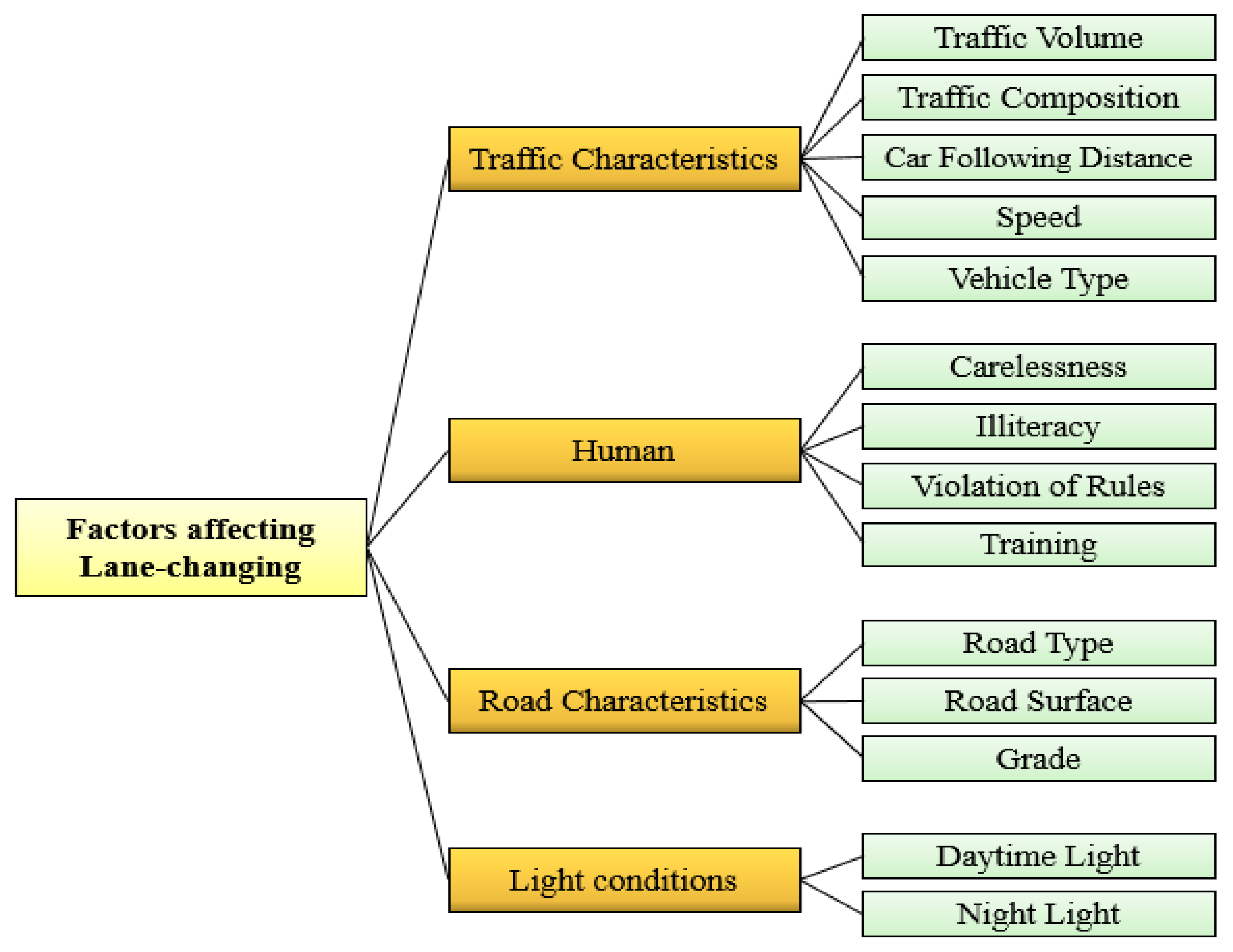
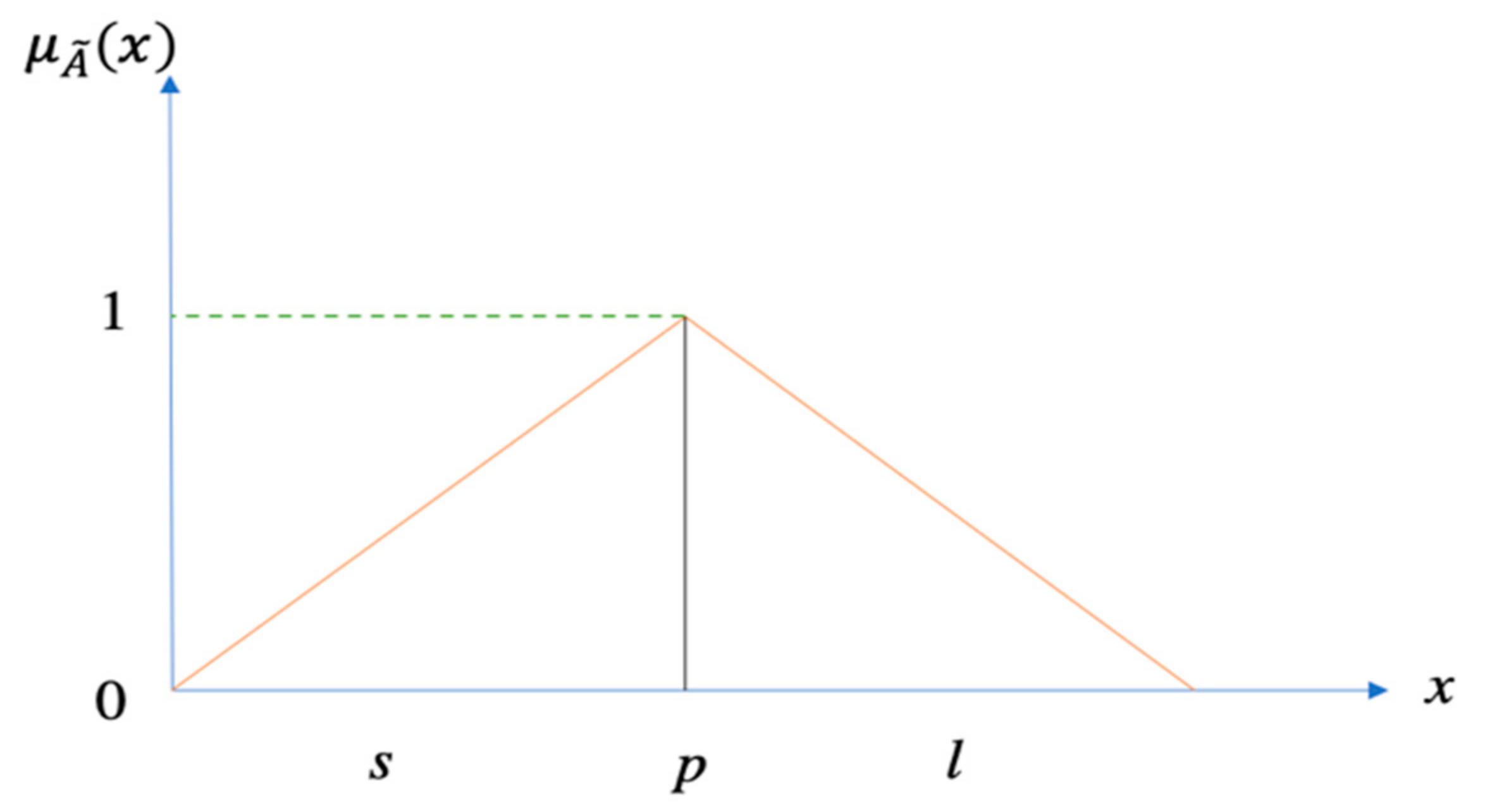
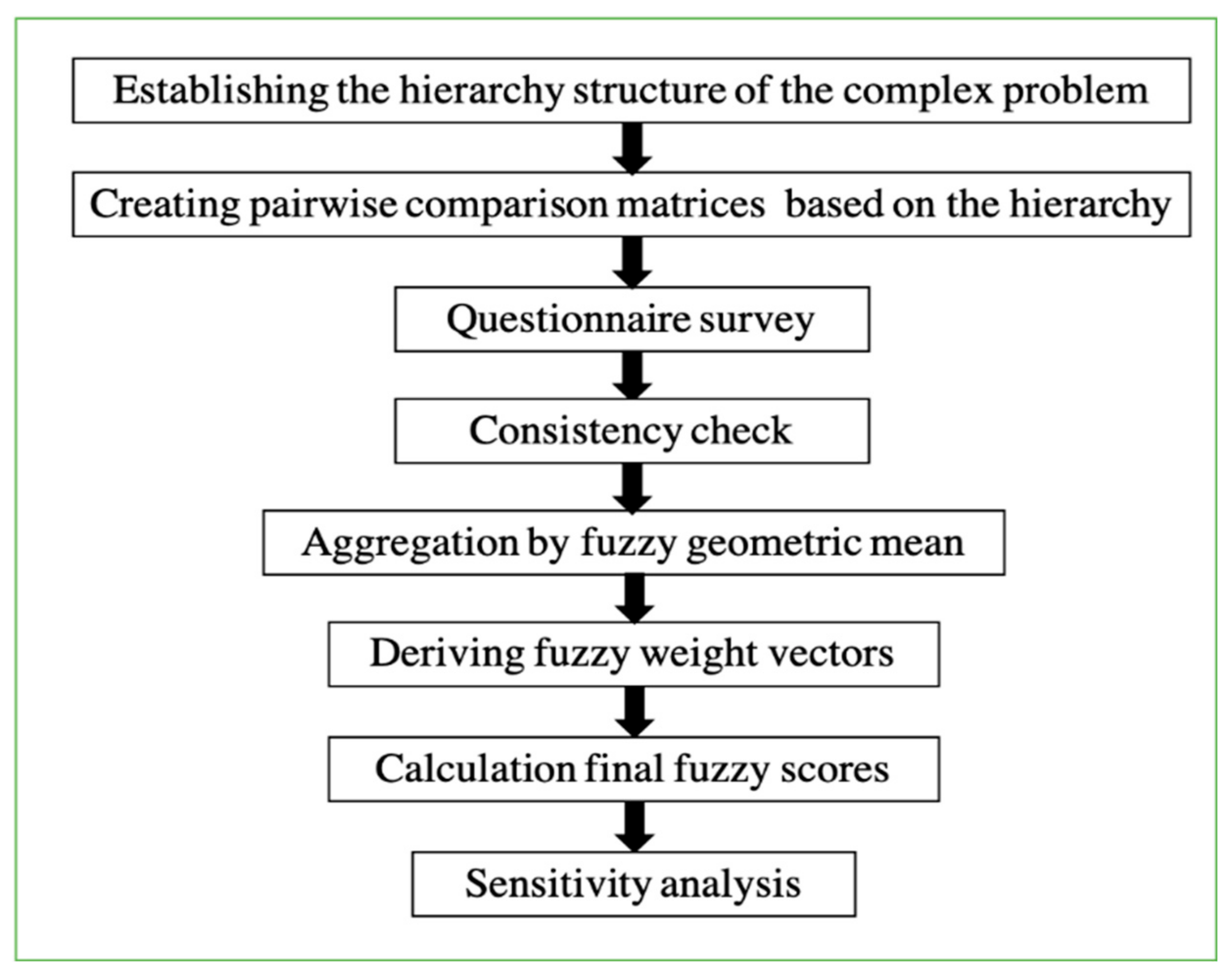
| Authors (Year of Publication) | Applications |
|---|---|
| Srisawat et al., 2017 [23] | Estimate the quality of transport logistics on a regional scale |
| Nanda and Singh, 2018 [24] | Evaluate the factors of road incidents |
| Danish Farooq and Sarbast Moslem, 2019 [25] | Estimated the significant driver behavior factors affecting the highway safety in the context of the city of Budapest, Hungary |
| M. Gul et al., 2018 [26] | The authors presented a risk assessment model based on FAHP for means in hazardous substance transportation |
| Shalini Kanuganti et al., 2016 [27] | Investigate the ranking of safety essentials of a particular group of rural roads |
| Pandian et al., 2016 [28] | Presented a model to optimize/minimize blind areas/spots for heavy transport vehicles |
| Yaqin He and Shengpin Du, 2016 [29] | A quantitative model of emergency categorization offered by focusing traffic guarantee power during the collision |
| Variable Description | Frequency | Percentage (%) |
|---|---|---|
| Number (N) | 70 | 100 |
| Age (years) | ||
| 18–30 | 14 | 20 |
| 31–50 | 34 | 48.5 |
| 51 above | 22 | 31.5 |
| Gender | ||
| male | 63 | 90 |
| female | 07 | 10 |
| Duration of driving license (years) | ||
| 1–5 | 11 | 15.71 |
| 6–15 | 37 | 52.85 |
| 16–25 | 22 | 31.42 |
| Education | ||
| Bachelor’s degree | 33 | 47.14 |
| MSC/PhD | 37 | 52.86 |
| Comparing the Selected Factors Importance in Response to Rrequent Lane-Changing | ||||
|---|---|---|---|---|
| Traffic Characteristics | Human Attributes | Road Characteristics | Light Conditions | |
| Traffic characteristics | (1, 1, 1) | (2, 3, 4) | (4, 5, 6) | (6, 7, 8) |
| Human | (1/2, 1/3, 1/4) | (1, 1, 1) | (6, 7, 8) | (4, 5, 6) |
| Road characteristics | (1/4, 1/5, 1/6) | (1/6, 1/7, 1/8) | (1, 1, 1) | (6, 7, 8) |
| Light conditions | (1/6, 1/7, 1/8) | (1/4, 1/5, 1/6) | (1/6, 1/7, 1/8) | (1, 1, 1) |
| Main Factor | Sub-Factor | Explanation and Related Reference |
|---|---|---|
| Traffic Characteristics (F1) | Traffic Volume (F1.1) | Traffic volumes were identified as the highly significant factors for modeling the driving behavior [40] |
| Traffic Composition (F1.2) | Traffic composition has statistically major impacts on collision occurrence [41] | |
| Following Distance (F1.3) | To ensure the safety distance for lane changing, a safe car-following distance should be reserved [42]. | |
| Speed (F1.4) | High-speeds variations within the same lane characterize situations with decline levels of service (LOS) and consequently unstable flow. These situations can cause greater accident risk [43] | |
| Vehicle Type (F1.5) | Vehicle type has been utilized in numerous traffic crash studies [44,45] | |
| Human (F2) | Carelessness (F2.1) | Previous studies confirmed that drivers with careless driver behavior might considerably raise the risk of traffic collisions [46,47] |
| Illiteracy (F2.2) | The study results revealed that most casualties in traffic collisions were illiterates for different age groups [48] | |
| Violation of Traffic Rules (F2.3) | Traffic violations were noted to be the leading risks threatening road safety [49] | |
| Training (F2.4) | Driving behavior is affected by training, experience, and personal characteristics [50] | |
| Road Characteristics (F3) | Road Type (F3.1) | A previous study analyzed the relationship between type of road infrastructure and crash involvement [51] |
| Road Surface (F3.2) | Previous study analysis indicated that deformations on pavement surface have a positive impact on lane-changing [52] | |
| Grade (F3.3) | Road safety problems may appear due to upgrade or downgrade sections [51] | |
| Light conditions (F4) | Daytime light (F4.1) | Dark lighting conditions are more likely to lead to fatal or severe injury crashes compared with daylight [53,54,55] |
| n | RI |
|---|---|
| 1 | 0 |
| 2 | 0 |
| 3 | 0.58 |
| 4 | 0.9 |
| 5 | 1.12 |
| 6 | 1.24 |
| 7 | 1.32 |
| 8 | 1.41 |
| Linguistic | Scale of Fuzzy Number |
|---|---|
| Extremely important | (8, 9, 10) |
| Very strong important | (6, 7, 8) |
| Important | (4, 5, 6) |
| Moderately important | (2, 3, 4) |
| Equally important | (1, 1, 1) |
| Intermediate values | (7, 8, 9), (5, 6, 7), (3, 4, 5), (1, 2, 3) |
| Level 1 | Level 2 | ||
|---|---|---|---|
| Main Factor | Weight | Sub-Factor | Weight |
| Traffic Characteristics | 0.5404 | Traffic Volume | 0.4071 |
| Traffic Composition | 0.1285 | ||
| Following Distance | 0.1565 | ||
| Speed | 0.3209 | ||
| Vehicle Type | 0.1150 | ||
| Human | 0.2232 | Carelessness | 0.2585 |
| Illiteracy | 0.1084 | ||
| Violation of Rules | 0.3989 | ||
| Training | 0.2748 | ||
| Road Characteristics | 0.1847 | Road Type | 0.6215 |
| Road Surface | 0.2280 | ||
| Grade | 0.1904 | ||
| Light conditions | 0.0882 | Daytime light | 0.8193 |
| Night Light | 0.1807 | ||
| Factor | Weight | Rank |
|---|---|---|
| Traffic Characteristics | 0.5404 | 1 |
| Human | 0.2232 | 2 |
| Road Characteristics | 0.1847 | 3 |
| Light conditions | 0.0882 | 4 |
| Factor | Local Weight | Final Weight | Rank |
|---|---|---|---|
| Traffic Volume | 0.4071 | 0.2200 | 1 |
| Traffic Composition | 0.1285 | 0.0694 | 8 |
| Following Distance | 0.1565 | 0.0846 | 5 |
| Speed | 0.3209 | 0.1734 | 2 |
| Vehicle Type | 0.1408 | 0.0761 | 6 |
| Carelessness | 0.2585 | 0.0577 | 10 |
| Illiteracy | 0.1084 | 0.0242 | 13 |
| Violation of Rules | 0.3989 | 0.0890 | 4 |
| Training | 0.2748 | 0.0614 | 9 |
| Road Type | 0.6215 | 0.1148 | 3 |
| Road Surface | 0.2280 | 0.0421 | 11 |
| Grade | 0.1904 | 0.0352 | 12 |
| Daytime light | 0.8193 | 0.0723 | 7 |
| Night Light | 0.1807 | 0.0159 | 14 |
| Factor | Weight | Weight after the Sensitivity Analysis | Rank |
|---|---|---|---|
| Traffic Characteristics | 0.5404 | 0.5500 | 1 |
| Human | 0.2232 | 0.2100 | 2 |
| Road Characteristics | 0.1847 | 0.1700 | 3 |
| Light conditions | 0.0882 | 0.0700 | 4 |
| Factor | Local Weight | Final Weight | New Rank |
|---|---|---|---|
| Traffic Volume | 0.4071 | 0.223905 | 1 |
| Traffic Composition | 0.1285 | 0.070675 | 7 |
| Following Distance | 0.1565 | 0.086075 | 4 |
| Speed | 0.3209 | 0.176495 | 2 |
| Vehicle Type | 0.1408 | 0.07744 | 6 |
| Carelessness | 0.2585 | 0.054285 | 10 |
| Illiteracy | 0.1084 | 0.022764 | 13 |
| Violation of Rules | 0.3989 | 0.083769 | 5 |
| Training | 0.2748 | 0.057708 | 8 |
| Road Type | 0.6215 | 0.105655 | 3 |
| Road Surface | 0.2280 | 0.03876 | 11 |
| Grade | 0.1904 | 0.032368 | 12 |
| Daytime light | 0.8193 | 0.057351 | 9 |
| Night Light | 0.1807 | 0.012649 | 14 |
Publisher’s Note: MDPI stays neutral with regard to jurisdictional claims in published maps and institutional affiliations. |
© 2022 by the authors. Licensee MDPI, Basel, Switzerland. This article is an open access article distributed under the terms and conditions of the Creative Commons Attribution (CC BY) license (https://creativecommons.org/licenses/by/4.0/).
Share and Cite
Moslem, S.; Farooq, D.; Jamal, A.; Almarhabi, Y.; Almoshaogeh, M.; Butt, F.M.; Tufail, R.F. An Integrated Fuzzy Analytic Hierarchy Process (AHP) Model for Studying Significant Factors Associated with Frequent Lane Changing. Entropy 2022, 24, 367. https://doi.org/10.3390/e24030367
Moslem S, Farooq D, Jamal A, Almarhabi Y, Almoshaogeh M, Butt FM, Tufail RF. An Integrated Fuzzy Analytic Hierarchy Process (AHP) Model for Studying Significant Factors Associated with Frequent Lane Changing. Entropy. 2022; 24(3):367. https://doi.org/10.3390/e24030367
Chicago/Turabian StyleMoslem, Sarbast, Danish Farooq, Arshad Jamal, Yahya Almarhabi, Meshal Almoshaogeh, Farhan Muhammad Butt, and Rana Faisal Tufail. 2022. "An Integrated Fuzzy Analytic Hierarchy Process (AHP) Model for Studying Significant Factors Associated with Frequent Lane Changing" Entropy 24, no. 3: 367. https://doi.org/10.3390/e24030367
APA StyleMoslem, S., Farooq, D., Jamal, A., Almarhabi, Y., Almoshaogeh, M., Butt, F. M., & Tufail, R. F. (2022). An Integrated Fuzzy Analytic Hierarchy Process (AHP) Model for Studying Significant Factors Associated with Frequent Lane Changing. Entropy, 24(3), 367. https://doi.org/10.3390/e24030367









